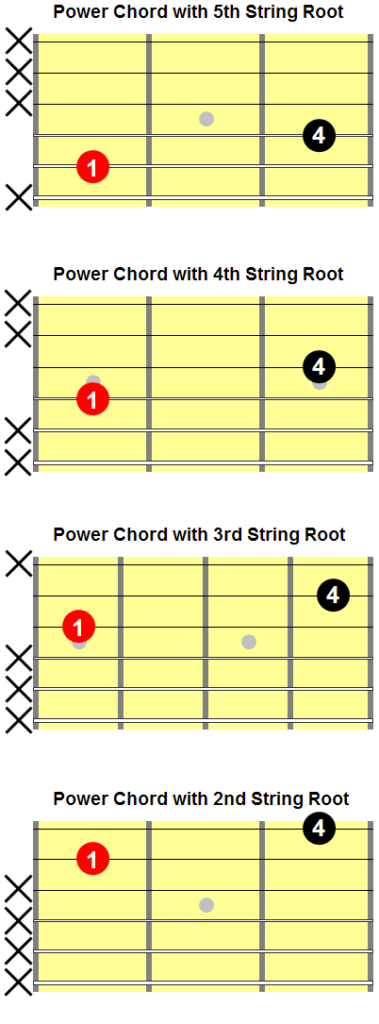A power chord is a two-note “chord.”
I put the word chord in quotes because technically a chord contains three or more notes, whereas a power chord only contains two notes, which makes it a diad.
However, you will almost never hear it referred to that way. It is commonly referred to as a power chord and I will use the same terminology throughout this series.
This post will cover how to construct a power chord. It will also provide common fingerings for the chord along with instruction on how to play them on a guitar with any root note.
Power Chords: Theory
The chord formula for a power chord is: 1, 5.
A power chord contains the first and fifth degrees of the major scale with the same root note.
C5 (or C Power Chord)
For example, a C power chord contains the notes C and G — the first and fifth notes in a C major scale (fig.1).
The notation for a power chord is the root note with the number 5 after it, reflecting the relationship between the two notes.
So the notation for a C power chord is C5.
Fig.1

F5 (or F Power Chord)
An F5 (or F power chord) contains the notes F and C — the first and fifth notes in an F major scale (fig.2).
Fig.2

Power Chords Built on all 12 Root Notes
The power chords based on all 12 root notes are shown in fig.3.
Fig.3

Power Chords: On a Guitar
Power chords are usually played on a guitar on two adjacent strings, although many of them can be played as open chords and they can all be played on two non-adjacent strings as well.
The most common fingering for a power chord is shown in fig.4.
Fig.4

This fingering will allow you to play a power chord with any root note:
- To play a C5, place your first finger on the C on the sixth string, eighth fret (fig.5a).
- To play an F5, place your first finger on the F on the sixth string, first fret (fig.5b).
Fig.5

Expanded Power Chords: Theory
A power chord can be expanded by doubling the root note. The second root note in an expanded power chord is played an octave higher than the first — the eighth note in the scale.
Expanded C5
For example, an expanded C power chord contains the notes C, G and the next highest C — the first, fifth and eighth notes in a C major scale (fig.6).
Fig.6

Expanded F5
An expanded F power chord contains the notes F, C and the next hightest F — the first, fifth and eighth notes in an F major scale (fig.7).
Fig.7

Expanded Power Chords: On a Guitar
The most common fingering for an expanded power chord is shown in fig.8.
Fig.8

This fingering will allow you to play an expanded power chord with any root note:
- To play an expanded C5, place your first finger on the C on the sixth string, eighth fret (fig.9a).
- To play an expanded F5, place your first finger on the F on the sixth string, first fret (fig.9b).
Fig.9

Root Notes on Other Strings
Power Chords
Power chords can be played on any two adjacent strings with root notes on the sixth, fifth, fourth, third and second strings.
The most common fingerings for power chords with fifth, fourth, third and second string root notes are shown in fig.10.
Fig.10

Expanded Power Chords
Expanded power chords can be played on any three adjacent strings with root notes on the sixth, fifth, fourth and third strings.
The most common fingerings for expanded power chords with fifth, fourth and third string root notes are shown in fig.11.
Fig.11

Chord Qualities
Power chords don’t contain a third scale degree, so they are neither major nor minor in quality.
Power chords have an open, powerful sound, especially when played with distortion in heavier styles of music.
Expanded power chords sound even heavier.
Related Posts
Related posts include:
